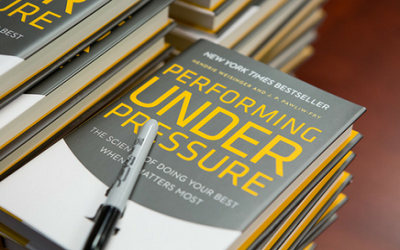Original publication: SHRM
Original publication date: July 13, 2015
No one truly thrives under pressure, whether it’s created by urgent deadlines or the need to perform in front of a large audience. Not athletes. Not entertainers. Not business stars. Some do manage pressure better than others, though, allowing them to perform at close to their potential when the outcome is important.
Those insights are based on a seven-year study of 12,000 individuals conducted by the Institute for Health and Human Potential, co-founded by training and performance expert and coach J.P. Pawliw-Fry. In the best-selling book Performing Under Pressure: The Science of Doing Your Best When It Matters Most(Crown Business, 2015), co-author Pawliw-Fry details the study’s findings; draws on the experiences of elite athletes, U.S. Navy SEALs, and Fortune 500 employees and managers; and offers strategies to reduce pressure and improve performance.
What hampers people’s performance under pressure?
Most people take a haphazard approach to pressure. People fall back on what their parents or teachers or coaches modeled for them. We also tend to have a negative view of our first physical manifestations of pressure—hot forehead, sweaty palms, racing heart. We push them away and end up fighting within ourselves and unable to execute the task in front of us.
What stymies business leaders from minimizing pressure in their organizations?
Most leaders are clueless about pressure and its impact on performance. They get anxious about their own goals and don’t realize that their emotions are infectious and spread to their teams and direct reports. Many also apply more pressure, thinking it will help their people. But since most of us really care about doing well, we already put enough pressure on ourselves.
How can managers alter the way their people view pressure and anxiety, with an eye toward improving performance?
When we are too attached to an outcome, we tighten up. We lose the ability to execute. Rather than outcome, keep people focused on the “integrity of inputs”—the things they can control. This makes them feel more confident and increases their chances of delivering a good performance.
For HR professionals, what are the telltale signs for how job candidates will handle high-pressure situations?
Oftentimes, you don’t know how people will handle pressure until you see them encounter it. Take the football quarterback. You can’t simulate the pressure and the speed of the NFL, so it’s hard to predict who will succeed and who will fail. To select the best performers under pressure, HR professionals need to leverage assessment tools and conduct rigorous interviews with candidates. And when you are doing reference interviews, be vigilant about getting information on the critical incidents when the person was put in a pressure situation. Ask for an example, then another example, then another.
What can businesspeople learn from Olympic athletes about how to perform under pressure?
The Olympic athletes and professional athletes I work with over-train and over-prepare to handle pressure. They are rigorous when it comes to self-knowing. They do a thorough assessment of their actions after a high-pressure situation. What happened? What did I learn? How did I prepare? They bring the rigor to that evaluation. Businesspeople have to start doing those types of evaluations and understand what led to their best performances to recreate that preparation plan.
Four attributes that help people perform under pressure are confidence, optimism, tenacity and enthusiasm–what you call a “COTE of armor.” What is it about those traits that help us succeed?
They become the outer shield that immunizes you from pressure, and each can be improved upon. They can help you block out that pressure moment and have confidence that you can deliver, and that you can be resilient and bounce back when you don’t. You have to put in the work to develop each trait. You can’t just hope that you’ll do well under pressure.
Adam Van Brimmer is a journalist and a freelance writer based in Georgia.

